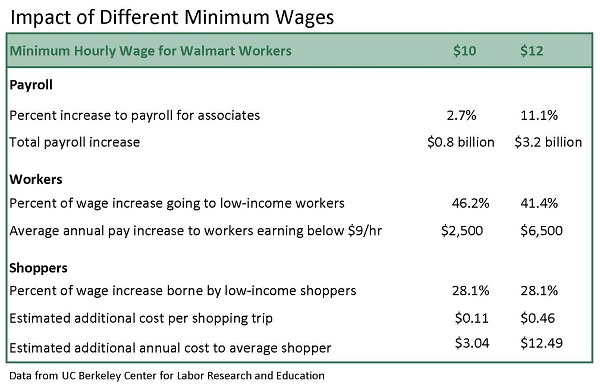
Walmart Grocery Checkout Line in Gladstone, Missouri courtesy of Walmart Corporate, CC BY 2.0.
Workers for the nation’s largest private employer are getting a pay raise. On February 19, Wal-Mart Stores, Inc. announced the wage increase and other investments in employees, which will affect 500,000 full- and part-time employees at both Walmart and Sam’s Club stores. The move comes after years of criticism of Wal-Mart’s employee treatment and low wages.
By April of this year, all U.S. employees will make at least $9 an hour, an increase of up to $1.75 for some workers. That minimum wage will be $10 for all U.S. employees by February 1, 2016, according to the company. Wal-Mart is also expanding employee training and education programs and has vowed to improve its much-maligned scheduling practices, and estimates that the investment in all of these new employee programs will be more than $1 billion this fiscal year. The news comes as calls to raise the federal minimum wage have been increasing.
Wal-Mart has been the focus of more than one argument about paying workers a higher wage. In 2013, the Democratic staff of the House Committee on Education and the Workforce analyzed data from Wisconsin’s Medicaid program and estimated that the 300 employees of a Walmart Supercenter in Wisconsin might cost taxpayers between $900,000 and $1.75 million per year in public benefits. According to a widely cited 2005 study by the Brennan Center for Justice, a nonprofit legal advocacy group operating out of the New York University School of Law, Wal-Mart employees made 28% less on average than workers at other large retailers, though they were paid slightly more on average than employees at discount retailers such as Kmart and Target. More recent data has shown similar trends; according to a July 2014 National Bureau of Economic Research (NBER) Working Paper, Wal-Mart cashiers are paid an average of $8.48 an hour, whereas the average wage of all U.S. cashiers was $11.22 an hour, according to the U.S. Census Bureau’s Current Population Survey. Workers have reportedly gone on strike over the last few years to protest the low wages.
“We’re strengthening investments in our people to engage and inspire them to deliver superior customer experiences,” said Wal-Mart CEO Doug McMillion.
The company is not the first to beat the government to the punch in raising minimum wage. Ikea, Gap, Old Navy, and other retailers have recently raised the wages of their lowest-paid workers. Several cities have raised the minimum wage, and while President Obama has pushed to increase the minimum wage on a federal level, the idea has not caught on in Congress.
Wal-Mart has received plenty of praise for the move to raise wages, but it should be noted that in some states the retailer didn’t have a choice. A third of Walmart stores are in states where the minimum wage has already been raised above the federal level of $7.25, and in nine states the minimum wage is already $9 per hour or more. With the additional consideration of a dropping unemployment rate, some analysts claim that the market is creating more pressure for better wages and benefits, regardless of employment regulations.
A popular argument against raising the minimum wage, especially by a company as large as Wal-Mart, is that the employer would have to drastically increase prices. However, an April 2011 research brief from the UC Berkeley Center for Labor Research and Education reported that if U.S. Walmart stores increased their minimum wage to $12 per hour, 41.4% of the income gain would benefit low-income workers (those with wages below 200% of the federal poverty level), who could earn an additional $1,670 to $6,500 per year. If Wal-Mart passed on the full cost of the wage increase to consumers through price increases, the average Walmart shopper would pay an extra $12.49 per year, of which 28.1% would affect low-income shoppers (those with wages below 200% of the federal poverty level).
Now that the largest retailer in the United States has raised its minimum wage across the board, who do you think will follow? Leave a comment below and let us know what you think.







Recent Comments